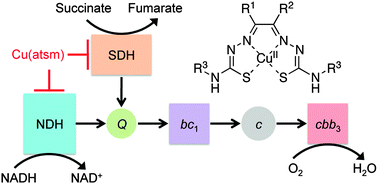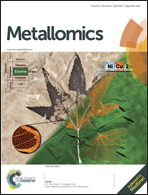Antimicrobial effects of copper(ii) bis(thiosemicarbazonato) complexes provide new insight into their biochemical mode of action†
Abstract
The copper(II) complexes of bis-thiosemicarbazones (Cu(btsc)) such as Cu(atsm) and Cu(gtsm) are neutral, lipophilic compounds that show promise as therapeutics for the treatment of certain neurological diseases and cancers. Although the effects of these compounds have been described at the cellular level, there is almost no information about their biochemical mode of action. In this work, we showed that Cu(atsm) and Cu(gtsm) displayed antimicrobial activities against the human obligate pathogen Neisseria gonorrhoeae that were more than 100 times more potent than Cu(NO3)2 salt alone. Treatment with Cu(btsc) also produced phenotypes that were consistent with copper poisoning, but the levels of intracellular copper were undetectable by ICP MS. We observed that Cu(btsc) interacted with proteins in the cell membrane. Systematic measurements of O2 uptake further demonstrated that treatment with both Cu(atsm) and Cu(gtsm) led to dose-dependent inhibition of respiratory electron transfer processes via succinate and NADH dehydrogenases. These dehydrogenases were not inhibited by a non-btsc source of CuII. The results led us to conclude that the biochemical mechanism of Cu(btsc) action is likely more complex than the present, simplistic model of copper release into the cytoplasm.


 Please wait while we load your content...
Please wait while we load your content...